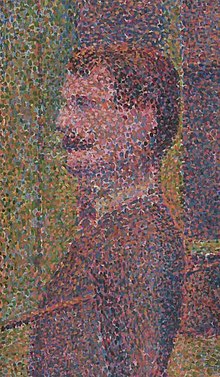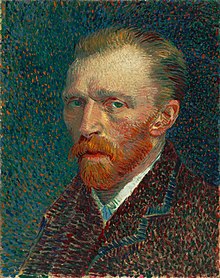Pointillism

Pointillism /ˈpɔɪnt[invalid input: 'i-']lɪzəm/ is a technique of painting in which small, distinct dots of color are applied in patterns to form an image. Georges Seurat and Paul Signac developed the technique in 1886, branching from Impressionism. The term "Pointillism" was first coined by art critics in the late 1880s to ridicule the works of these artists, and is now used without its earlier mocking connotation.[1] The movement Seurat began with this technique is known as Neo-Impressionism. The Divisionists, too, used a similar technique of patterns to form images, though with larger cube-like brushstrokes.[2]
Technique
The technique relies on the ability of the eye and mind of the viewer to blend the color spots into a fuller range of tones. It is related to Divisionism, a more technical variant of the method. Divisionism is concerned with color theory, whereas pointillism is more focused on the specific style of brushwork used to apply the paint.[1] It is a technique with few serious practitioners today,[3] and is notably seen in the works of Seurat, Signac and Cross. However, see also Andy Warhol's early works, and Pop Art.


Practice
The practice of Pointillism is in sharp contrast to the traditional methods of blending pigments on a palette. Pointillism is analogous to the four-color CMYK printing process used by some color printers and large presses that place dots of Cyan (blue), Magenta (red), Yellow, and Key (black). Televisions and computer monitors use a similar technique to represent image colors using Red, Green, and Blue (RGB) colors.[4]
If red, blue, and green light (the additive primaries) are mixed, the result is something close to white light (see Prism (optics)). Painting is inherently subtractive, but Pointillist colors often seem brighter than typical mixed subtractive colors. This may be partly because subtractive mixing of the pigments is avoided, and partly because some of the white canvas may be showing between the applied dots.[4]
The painting technique used for Pointillist color mixing is at the expense of the traditional brushwork used to delineate texture.[4]
The majority of Pointillism is done in oil paint. Anything may be used in its place, but oils are preferred for their thickness and tendency not to run or bleed.[5]
Music
Pointillism also refers to a style of 20th-century music composition. Different musical notes are made in seclusion, rather than in a linear sequence, giving a sound texture similar to the painting version of Pointillism.[6] This type of music is also known as punctualism or klangfarbenmelodie.
Notable artists


- Charles Angrand
- Chuck Close
- Henri-Edmond Cross
- Henri Delavallée
- Albert Dubois-Pillet
- Louis Fabien (pseudonym)
- Georges Lemmen
- Maximilien Luce
- Camille Pissarro
- John Roy
- Georges Seurat
- Paul Signac
- Vincent van Gogh
- Théo van Rysselberghe
- Hippolyte Petitjean
- Jan Toorop
Notable paintings
- A Sunday Afternoon on the Island of La Grande Jatte by Georges Seurat
- Bathing at Asnieres by Georges Seurat
- The Windmills at Overschie by Paul Signac
- Banks of Seine by Georges Seurat
- A Coastal Scene by Théo van Rysselberghe
- Family in the Orchard by Théo van Rysselberghe
- Countryside at Noon by Théo van Rysselberghe
- Afternoon at Pardigon by Henri-Edmond Cross
- Rio San Trovaso, Venice by Henri-Edmond Cross
- The Seine in front of the Trocadero by Henri-Edmond Cross
- The Pine Tree at St. Tropez by Paul Signac
- Against the Enamel of Background Rhythmic with Beats and Angels by Paul Signac
- The Yellow Sail, Venice by Paul Signac
- Notre Dame Cathedral by Maximilien Luce
- Le Pont De Pierre, Rouen by Charles Angrand
- The Beach at Heist by Georges Lemmen
- Aline Marechal by Georges Lemmen
- Vase of Flowers by Georges Lemmen
Gallery
-
Camille Pissarro, 1888, La Récolte des pommes, oil on canvas, 61 x 74 cm, Dallas Museum of Art
-
Paul Signac, 1901, L'Hirondelle Steamer on the Seine, oil on canvas, National Gallery in Prague
-
Henri Edmond Cross, 1903-04, Regatta in Venice, oil on canvas, 73.7 x 92.7 cm, Museum of Fine Arts, Houston
-
Jean Metzinger, c.1906, Femme au Chapeau (Woman with a Hat), oil on canvas, 44.8 x 36.8 cm, Korban Art Foundation
-
Robert Delaunay, 1906, Portrait de Metzinger, oil on canvas, 55 x 43 cm
-
René Schützenberger, 1911, La Coiffure, oil on canvas, 121 × 91 cm
-
Hippolyte Petitjean, 1919, Femmes au bain, oil on canvas, 61.1 × 46 cm, private collection
-
George Graham, 1935-38, The Creation, oil on canvas, 50 x 40 inches, Hasting Museum and Art Gallery [7]
See also
- Divisionism
- Micromontage, similar technique in music
- Neo-impressionism
- Punctualism (music)
- Stippling
References
- ^ a b "Pointillism." Artcyclopedia. Artists by Movement. John Malyon/Artcyclopedia, 2007. Web. http://www.artcyclopedia.com/history/pointillism.html
- ^ Ruhrberg, Karl. "Seurat and the Neo-Impressionists". Art of the 20th Century, Vol. 2. Koln: Benedikt Taschen Verlag, 1998. ISBN 3822840890.
- ^ "makeyourideasart.com". Retrieved 25 September 2013.
- ^ a b c Vivien Greene, Divisionism, Neo-Impressionism: Arcadia & Anarchy, Guggenheim Museum Publications, 2007, ISBN 0892073578
- ^ Nathan, Solon. "Pointillism Materials." Web. 9 Feb 2010. http://www.si.umich.edu/chico/emerson/pntmat.html
- ^ Britannica - The Online Encyclopedia http://www.britannica.com/
- ^ Hasting Museum and Art Gallery
External links
- Georges Seurat, 1859-1891, a fully digitized exhibition catalog from The Metropolitan Museum of Art Libraries
- Signac, 1863-1935, a fully digitized exhibition catalog from The Metropolitan Museum of Art Libraries









![George Graham, 1935-38, The Creation, oil on canvas, 50 x 40 inches, Hasting Museum and Art Gallery [7]](http://upload.wikimedia.org/wikipedia/commons/thumb/b/b4/The_Creation_-_George_Graham.jpg/120px-The_Creation_-_George_Graham.jpg)